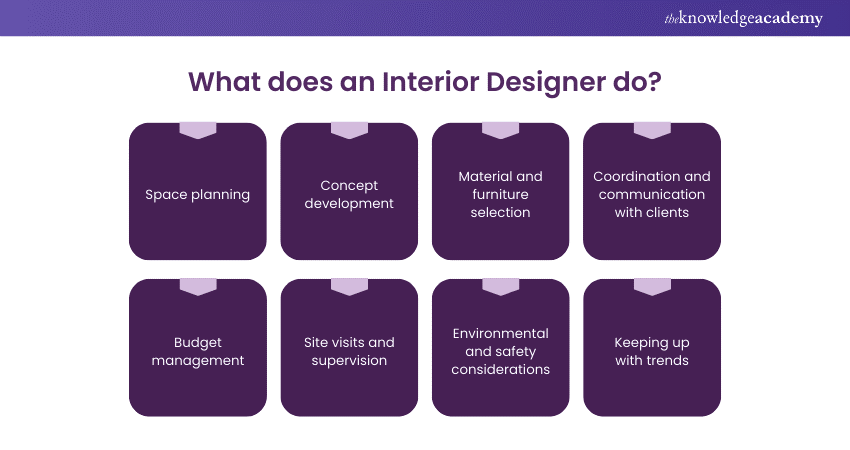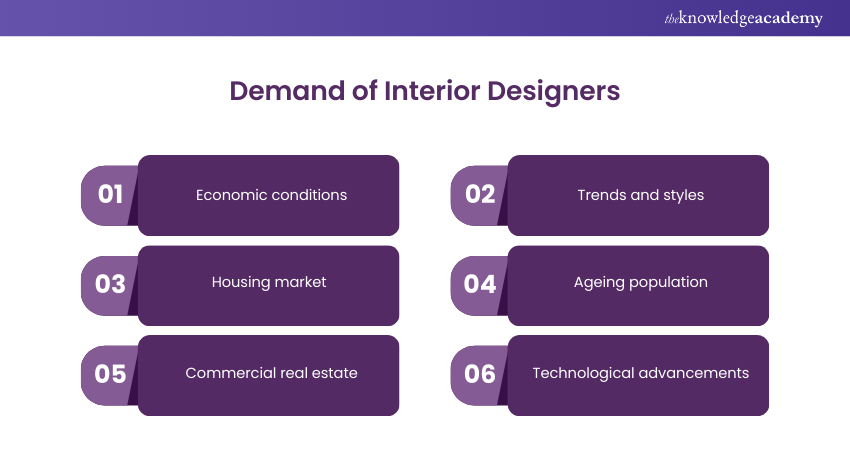We may not have the course you’re looking for. If you enquire or give us a call on +44 1344 203 999 and speak to our training experts, we may still be able to help with your training requirements.
Training Outcomes Within Your Budget!
We ensure quality, budget-alignment, and timely delivery by our expert instructors.

If you are curious to know What Does an Interior Designer Do, this blog is just for you. Interior Designers are the creative minds behind stylish and functional spaces. They select colours, furniture, and decor to transform ordinary spaces into inviting havens. They transform spaces into proper, inspiring settings that improve life quality & create lasting effects on those who use them.
From selecting the perfect colour to arranging furniture with an artistic eye, Interior Designers have the expertise to turn spaces into personalised havens. Read this blog to learn everything about Interior Designers, such as who Interior Designers are and What Does an Interior Designer Do.
Table of Contents
1) Who is an Interior Designer?
2) What Does an Interior Designer do?
3) Types of Interior Designers
4) Demand for Interior Designers
5) Conclusion
Who is an Interior Designer?
An Interior Designer is a professional who specialises in designing functional and beautiful interior spaces for houses, offices, commercial areas, and various other spaces. Interior Designers collaborate with their clients to thoroughly understand their needs, style and design preferences, and budget limits. There are various factors that Interior Designer takes into consideration such as colour, themes, furniture design, flooring, and decorative elements to create a tuneful design.
They work closely with Contractors, Architects, architects, and various other professionals to make sure that the design plans are executed effectively and under specific rules and regulations. Their main job is to create spaces that not only dwell with the client’s personality and living style but also maximise the space's functionality.
If you want to elevate your skills and turn your passion into a rewarding career, enrol in our complete Interior Design Training now!
What Does an Interior Designer do?
The following are the key responsibilities of an Interior Designer:

1) Space planning: One of the major responsibilities of an Interior Designer is space planning. They examine the space area and arrange fixtures, furniture, and elements to optimise functionality and flow. Interior Designers consider how people move within the space, ensuring that there is a natural and intuitive arrangement that suits the purpose of the room.
2) Concept development: Interior Designers are responsible for transforming the client's vision, preferences, and needs into a design concept. It demands creative thinking and the ability to interpret the client’s input. This is done after considering colour, styles, and themes.
3) Material and furniture selection: Selecting suitable material and furniture is important in achieving the desired look and feel of a space. Interior Designers must have deep knowledge of various materials, properties, and their potential applications.
4) Coordination and communication with clients: Effective communication and collaboration with clients are important to ensure the design aligns with the client’s expectations. Interior Designers must actively listen to client's aspirations, preferences, and concerns.
5) Budget management: Staying within a preplanned budget is a crucial aspect of an Interior Designer’s role. Designers must find an innovative solution that meets the client’s demand while respecting budget limitations.
6) Site visits and supervision: Interior Designers are involved in the implementation phase of the project. They visit the site regularly to monitor progress, address any issues and change as per their needs.
7) Environmental and safety considerations: Interior Designers are responsible for ensuring that their designs meet building codes, safety regulations and environmental standards. They consider fire safety, accessibility for people with disabilities and using environmentally friendly materials.
8) Keeping up with trends: To provide clients with up-to-date and relevant design options, Interior Designers stay informed about the latest trends in the industry. They attend design exhibitions and read industry publications.
Ready to take your drafting and design skills to the next level? Join our AutoCAD Training now!
Types of Interior Designers
There are various types of Interior Designers, each having its distinct specialised field. Following are some of the common types of Interior Designers:
1) Residential Interior Designer: The goal of Residential Interior design is to create stylish and functional settings for living. While working on houses, apartments, and other residential properties, they pay attention to the homeowner's tastes and style of life into considerations.
2) Commercial Interior Designer: Their focus is not confined to homes but also extends to those places like hotels and offices as well as entertainment venues like malls and restaurants. The purpose of their design is visual appeal and functionality, suited to the needs of different businesses and customers.
3) Hospitality Interior Designer: With a focus on restaurants, hotels, and resorts, hospitality Interior Designers aim to give visitors a comfortable and enjoyable stay. To create inviting places, they take into factors like atmosphere, utility, and brand identity.
4) Healthcare Interior Designer: Healthcare Designers are found in medical facilities, clinics, hospitals, and the care of assisted living. They prioritise functionality, hygiene, and patient comfort, often adhering to strict regulations and guidelines.
5) Kitchen and Bath Designer: The Designers concentrate on the development of the kitchen and bathroom spaces more than the other inner areas of the house. They scrutinise such elements as cabinets, fixtures and layouts, so they function effectively yet look beautiful.
6) Retail Interior Designer: Retail Designers create store layouts which meet customers’ demands and uplift their shopping experiences in the meantime. Regarding this matter, they are concerned with the products’ placement, lighting and signs to manage the consumer behaviors.
If you are passionate about engineering and want to learn about structural designs, check out our Revit Structure Course!
Demand for Interior Designers
The demand for Interior Designers can explicitly differ depending on factors such as location, economic conditions and trends in housing and commercial real-estate developments. However, in general, the demand for Interior Designers tends to be influenced by several key factors, including:

1) Economic conditions: When the economy is in stability, people and firms are more often involved with the Interior Design services. In a period of economic contraction, demand for these services can also shrink as the people and business make tough decisions on cutting their basic expenses.
2) Housing market: The desired quantity for residential Interior Designs also closely depends on the housing market. The housing market is usually driven by demand during the booming phase and homeowners look for Interior Design services to improve the look and the value of their properties. Additionally, when the market is going through a recession phase, the demand may decrease.
3) Commercial real estate: The demand for commercial Interior Designers relies on the state of commercial real estate. With a rising number of new businesses opening their doors or others expanding to existing and renovating their spaces, the need is high for Interior Design services in commercial businesses.
4) Trends and styles: The impact of Interior Design fashions and styles on customer’s choice can significantly increase Designers’ demand. For instance, if there is a rising interest in sustainable or eco-friendly design, the Designers who specialise in these fields are more likely to experience an increase in demand.
5) Ageing population: Since more and more people are ageing, the design service centers may have more demand in the area of the older generation accommodations, including accessible designs for their ease of living at the old age time.
6) Technological advancements: The use of technology, such as Virtual Reality and 3D Modelling can impact the Interior Designers demands. Clients reach Designers to get those who use these tools to design more immersive and accurate experiences.
If you want to elevate your skills and turn your passion into a rewarding career, join our complete Interior Design Training now!
Conclusion
We hope that you enjoyed reading this blog on What Does an Interior Designer Do. We have covered almost everything about Interior Designers, such as who Interior Designer is, their key responsibilities and how the demand for Interior Designers is affected by several factors. By breathing life into spaces and enhancing the way we experience our surroundings, Interior Designers play a crucial role in shaping the world around us.
Are you ready to bring your design visions to life in stunning 3DS? Join our 3DS Max Training!
Frequently Asked Questions

To pursue a career in Interior Design, receiving a degree in Interior Design or a similar discipline, along with gaining hands-on experience through internships, is necessary.

Interior Designers charge either a flat fee for a project or an hourly rate ranging from 40 GBP to 150 GBP. Depending on the project's size and complexity, they charge a percentage of the total project cost, often between 10% and 20%.

The Knowledge Academy takes global learning to new heights, offering over 30,000 online courses across 490+ locations in 220 countries. This expansive reach ensures accessibility and convenience for learners worldwide.
Alongside our diverse Online Course Catalogue, encompassing 17 major categories, we go the extra mile by providing a plethora of free educational Online Resources like News updates, Blogs, videos, webinars, and interview questions. Tailoring learning experiences further, professionals can maximise value with customisable Course Bundles of TKA.

The Knowledge Academy’s Knowledge Pass, a prepaid voucher, adds another layer of flexibility, allowing course bookings over a 12-month period. Join us on a journey where education knows no bounds.

The Knowledge Academy offers various Office Applications Training including Interior Design Training, AutoCAD Electrical Training and V-RAY Training. These courses cater to different skill levels, providing comprehensive insights into Interior Design.
Our Office Applications Blogs cover a range of topics offering valuable resources, best practices, and industry insights. Whether you are a beginner or looking to advance your Business Improvement skills, The Knowledge Academy's diverse courses and informative blogs have you covered.
Upcoming Office Applications Resources Batches & Dates
Date
 Interior Design Course
Interior Design Course
Fri 3rd Jan 2025
Fri 7th Mar 2025
Fri 2nd May 2025
Fri 4th Jul 2025
Fri 5th Sep 2025
Fri 7th Nov 2025







 Top Rated Course
Top Rated Course


 If you wish to make any changes to your course, please
If you wish to make any changes to your course, please


